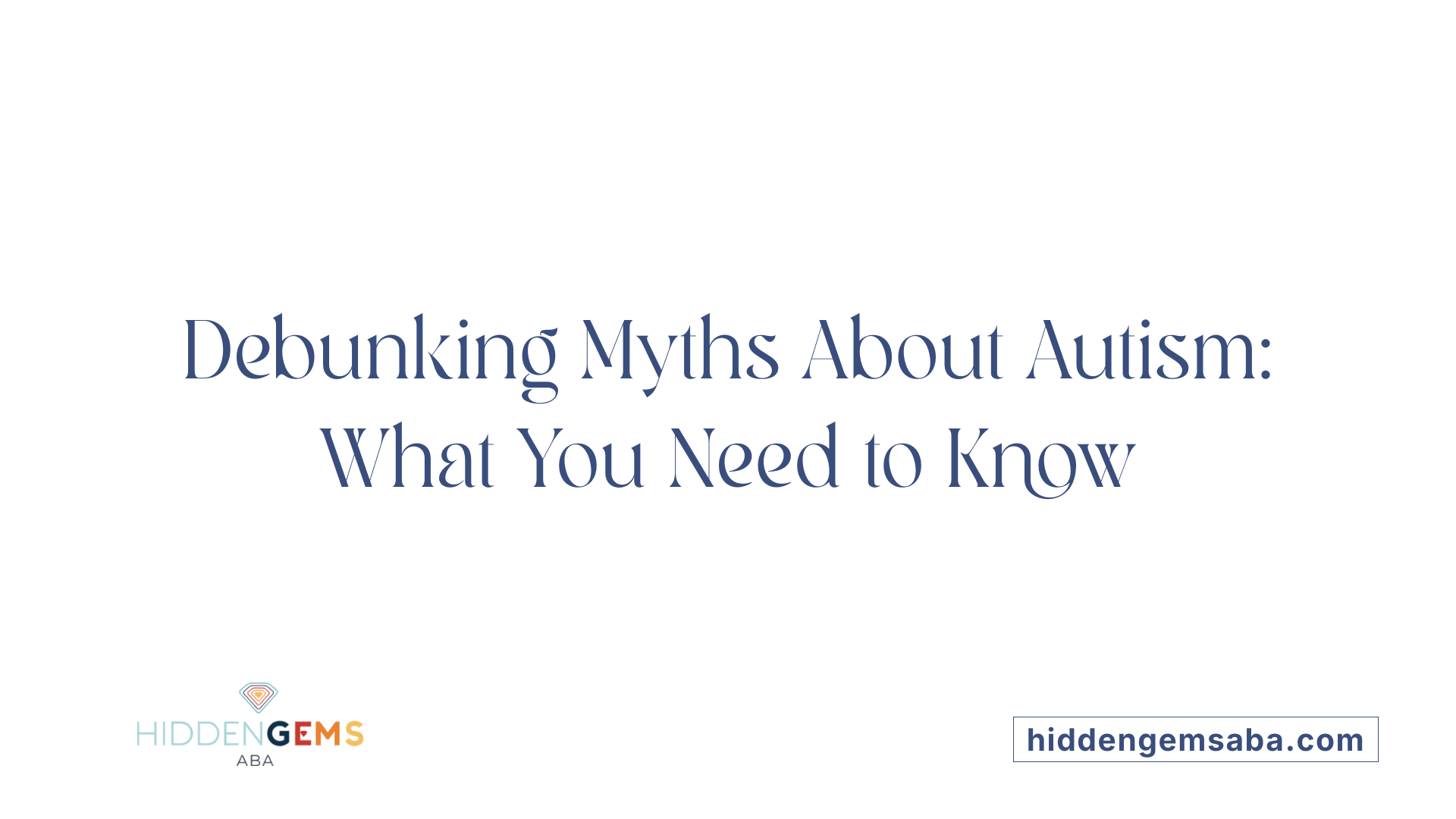Exploring the Complexity and Diversity of Autism
The question 'Is everyone on the autism spectrum?' often arises in discussions about neurodiversity and human variation. Autism Spectrum Disorder (ASD) is a complex, lifelong neurodevelopmental condition that affects social communication, behavior, and sensory processing. While it is widely recognized that autism encompasses a broad range of traits and abilities, not everyone has an autism diagnosis. This article delves into what ASD truly is, the concept of neurodiversity, common misconceptions, and how the spectrum manifests across different individuals, exploring whether everyone might fall somewhere along this range.
What Is Autism Spectrum Disorder and Its Key Traits

What is autism spectrum disorder (ASD) and what are its key characteristics?
Autism Spectrum Disorder (ASD) is a neurodevelopmental condition that influences how a person's brain works, affecting social interaction, communication, learning, and behavior. It is not an illness but a different way people's brains develop and function.
ASD includes a broad range of symptoms and severities, which is why it is called a spectrum. This means that the experiences of autistic individuals can vary widely. Some may need minimal or no support, while others may require help daily to manage their needs.
Core features of autism
Autistic people often have difficulties in communication and may find making eye contact or understanding facial expressions challenging. They may also display repetitive behaviors or intense interests in specific topics. Sensory sensitivities are common; bright lights, loud noises, or certain textures can be overwhelming or distressing.
Range of symptoms and levels of severity
Symptoms can appear very early in life or may become noticeable later. Diagnosis is usually made by a specialist through assessments that look at developmental history, behavior, and cognitive skills. Although the severity varies, early diagnosis and tailored interventions can significantly improve quality of life.
Differences in communication, behavior, and sensory sensitivities
Communication differences are a hallmark of ASD, including delayed speech, limited use of gestures, or challenges understanding non-verbal cues. Behaviorally, some individuals might engage in repetitive motions or insist on routines. Sensory sensitivities might make certain sounds, lights, or textures intolerable, leading to stress or discomfort.
In summary, autism spectrum disorder encompasses a wide array of features. While some individuals might primarily face communication challenges, others might excel in certain areas while struggling in others. Understanding these diverse traits fosters better support and inclusion for autistic individuals.
Understanding Neurodiversity and Spectrum Profiles

What is neurodiversity, and how does it relate to autism?
Neurodiversity is the idea that neurological differences like autism are natural variations of the human mind, not illnesses to be fixed. It promotes the view that brains operate in many diverse ways, and these differences should be accepted, respected, and celebrated. Many autistic individuals see their condition as a different way of thinking or processing the world, rather than a disability. The neurodiversity movement encourages society to make accommodations and provide support that affirms these differences, fostering inclusion and reducing stigma.
How does the concept of a spectrum help us understand the diversity among autistic individuals?
Autism is described as a spectrum to reflect the wide variety of experiences among autistic people. Instead of seeing autism as one single condition, the spectrum recognizes that each individual has a unique mix of abilities, strengths, and difficulties. For some, support needed may be minimal; for others, daily assistance might be essential.
Many neurodivergent individuals exhibit "spiky profiles," meaning their abilities and challenges vary greatly across different areas. For example, a person might have strong visual skills but difficulties with social communication. These variations illustrate the rich diversity found within the spectrum, highlighting that no two autistic individuals are exactly alike.
Common features like 'spiky profiles' in neurominorities
Most neurodivergent individuals tend to have uneven profiles of abilities, often described as "spiky," with significant peaks and troughs in skills such as cognition, language, or sensory processing. This pattern showcases how neurodivergence encompasses a broad range of traits and strengths, which can sometimes mask each other. Understanding this variability helps foster awareness that autism and related neurodivergent conditions do not follow a one-size-fits-all model, emphasizing the importance of personalized support.
| Aspect | Variability | Description |
|---|---|---|
| Spectrum | Wide range of traits | Autism includes diverse cognitive, social, sensory, and behavioral profiles |
| Spiky profiles | Uneven skill distribution | Individuals often show remarkable strengths in some areas and challenges in others |
| Neurodiversity | Natural brain variations | Celebrates diverse ways of thinking and processing information |
This understanding underscores the importance of recognizing each person’s unique neuroprofile, promoting a more inclusive and respectful society.
Dispelling Misconceptions About Autism

What misconceptions exist about autism and its spectrum, and how can they be clarified?
Many common beliefs about autism are based on outdated ideas or misinformation. Some think autism is caused by bad parenting or infections, but in reality, it is a neurodevelopmental condition that results from multiple genetic factors. Others believe autism is a disease or an illness that can be cured, but it is actually a lifelong difference in how the brain processes information.
Autism is best understood as a spectrum, meaning each individual has a unique mix of strengths, challenges, and behavioral traits. For example, some autistic people may struggle with communication and social interaction, while others might excel in specific areas like arts or math. This diversity—called neurodiversity—includes people with varying intellectual abilities, from below average to above average intelligence.
It is also a misconception that vaccines cause autism. Extensive scientific research has found no link between vaccination and autism, contradicting myths that suggest otherwise.
Recognizing that autism is lifelong and not something to be 'cured' encourages a focus on support, therapy, and accommodations that improve quality of life. Many autistic individuals live independently, attend college, and work successfully.
Understanding these facts helps us move away from misconceptions, fostering greater acceptance and support for autistic people, and recognizing their capabilities and individuality.
Are We All on the Autism Spectrum?
What does it mean to be 'on the spectrum'?
Autism spectrum disorder (ASD) is a term that describes a range of neurodevelopmental differences affecting social communication, behaviors, and sensory processing. When someone is said to be 'on the spectrum,' it means they exhibit traits or characteristics associated with autism, such as difficulties with social interactions or sensory sensitivities. However, it’s important to note that autism is a lifelong variation in brain development and isn’t an illness or disease. Each person on the spectrum has a unique combination of strengths and challenges, which can change over time.
How do diagnosed autism and traits in the general population differ?
Not everyone who shows traits like social awkwardness, intense focus, or sensory sensitivities has autism. Many individuals may experience these traits subtly or only occasionally, without meeting the criteria for an autism diagnosis. For example, a person might prefer solitary activities or have specific interests without any significant communication or social difficulties. Autism diagnoses are based on a comprehensive evaluation of behaviors and development, whereas traits can be present without a clinical diagnosis.
Are many people not diagnosed but have overlapping traits?
Yes, many people may have neurodivergent traits that overlap with autism but remain undiagnosed. Some adults, especially women, might not meet traditional diagnostic criteria but still experience sensory sensitivities or social challenges. These traits can be considered part of the broader spectrum of neurodiversity, reflecting natural variations in brain functioning. The idea of being 'a little bit autistic' often refers to this overlap, where traits are present but do not necessarily impair daily functioning.
Can these traits be present subtly or go undiagnosed?
Absolutely. Traits associated with autism can be present from a young age but might not be recognized until later in life or not at all. Many adults, particularly those who do not fit the stereotypical image of autism, may never receive a diagnosis. These subtle or hidden traits can influence how individuals perceive the world or interact with others, even if they do not identify as autistic. Awareness and understanding of this spectrum help recognize that neurodiversity exists across a wide range of experiences beyond diagnosed autism cases.
| Aspect | Description | Additional Notes |
|---|---|---|
| Spectrum Definition | Range of neurodevelopmental profiles | Includes various levels of support needs |
| Diagnosed Autism | Meets specific clinical criteria | Usually identified early, but diagnosis can be delayed |
| Traits in General Population | Possible, everyday behaviors | Not necessarily impairing or diagnosable |
| Subtle Traits | Hidden or mild signs | Often undetected, especially in adults |
| Variability | Different strengths and challenges | Each person's profile is unique |
The Importance of Visual Aids and Support Tools

How can visual aids help in understanding the autism spectrum?
Visual aids, such as charts, diagrams, neuroimaging images, and dynamic visualizations, play a crucial role in making the complex nature of the autism spectrum more accessible. Because ASD encompasses a wide range of traits, behaviors, and abilities, visual tools help illustrate this diversity clearly.
For example, diagrams and models can showcase the varying profiles within the spectrum, highlighting how some individuals may need minimal support while others require continuous assistance. Eye-tracking scans can show differences in how autistic people process social cues and facial expressions, emphasizing the variability between individuals.
Neuroimaging data visualizations reveal insights into the neural mechanisms underlying ASD, such as different patterns of brain activity or connectivity. Additionally, pie charts or multidimensional graphs can depict the overlapping traits and strengths, making it easier to understand the personalized nature of each person’s experience.
Overall, visual representations bridge gaps in understanding by translating abstract neurodevelopmental concepts into tangible images. They foster a deeper appreciation of the spectrum’s range, supporting greater empathy, acceptance, and tailored support strategies for autistic individuals.
Embracing the Spectrum of Human Neurodiversity
Understanding that autism is a spectrum with a diverse array of traits underscores the importance of acceptance, support, and recognition of human neurodiversity. While not everyone is autistic, many possess traits that reflect the broad variability within all human brains. Clarifying misconceptions and educating society about the complexity of autism can lead to more inclusive environments where all individuals are valued for their unique contributions. Recognizing the spectrum not only broadens our understanding of autism but also enriches our appreciation of the natural variations that exist across humanity.



.avif)


